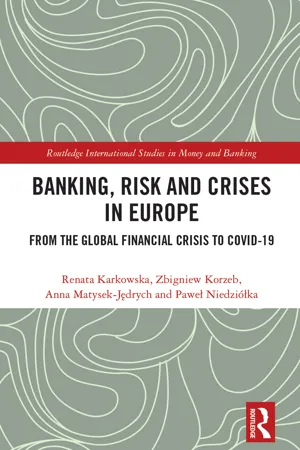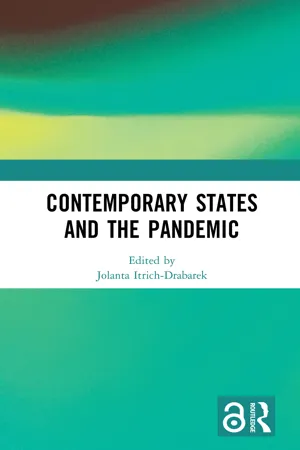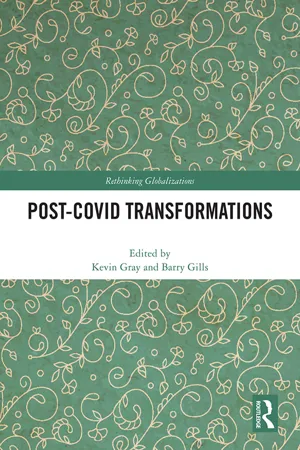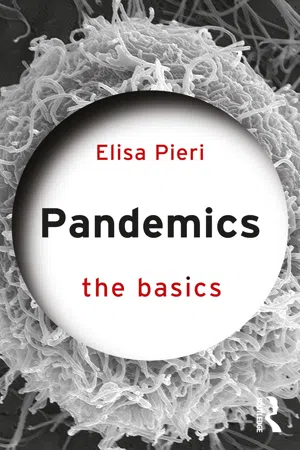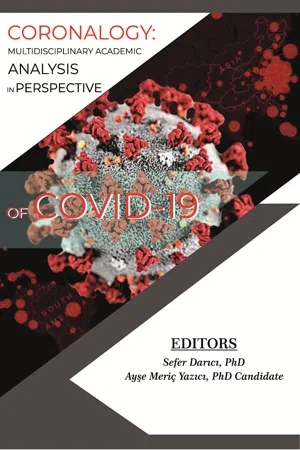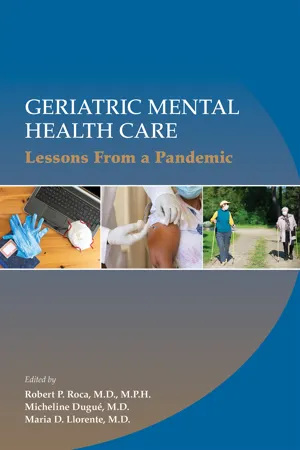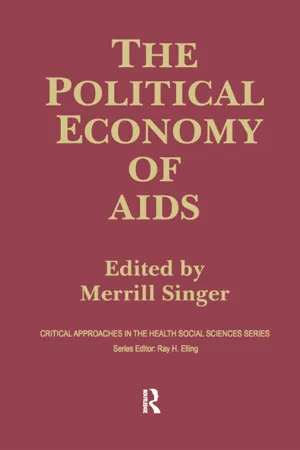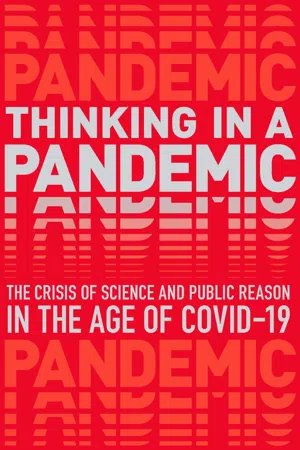History
Pandemic
A pandemic is an outbreak of a disease that occurs over a wide geographic area and affects an exceptionally high proportion of the population. Pandemics have occurred throughout history, with notable examples including the Black Death in the 14th century and the Spanish flu in the early 20th century. These events have had significant social, economic, and political impacts.
Written by Perlego with AI-assistance
Related key terms
Related key terms
1 of 4
Related key terms
1 of 3
10 Key excerpts on "Pandemic"
- Arpit Jain, Abhinav Sharma, Jianwu Wang, Mangey Ram(Authors)
- 2022(Publication Date)
- River Publishers(Publisher)
Ailments and illness have tormented humankind since the earliest days of our mortal flaw. Yet, moving to aggregarion, communities augmented the spread drastically. The more edified the people became with exotic trading avenues with augmented commerce with various populaces of individuals, faunae, and ecosystems, the more probable Pandemics became. There have been numerous critical ailment outbursts and Pandemics chronicled, including Spanish Flu, Hong Kong Flu, SARS, COVID-19, Ebola, Zika, etc. The expression “Pandemic” has barely been characterized by numerous clinical writings; however, there are some significant attributes of a Pandemic, including varied geographic reach, illness development, novelty, brutality, high mortality rates and instability, reduce populace immunity, and contagious and infectious, which assist to comprehend the problem better in the event that we analyze similitudes and contrasts amongst them. The Pandemic-related causalities can be correlated to tremendous adverse effects on wellbeing, financial system, civilization, and safety of national and worldwide publics. Also, they have instigated noteworthy political and societal disturbance. However, the healthcare improvements have been powerful assets in mitigating the impacts.1.2 Definition Of Pandemics
Pandemic is derived from two Greek words: pan meaning “all” and demos meaning “the individuals” [2 ]. A Pandemic is a wide-reaching spread of a novel disease. A Pandemic happens when a novel infection shows up and spreads the world over and the vast majority does not have the obligatory immunity. Infections that have instigated past Pandemics normally originated from animals. Studies suggest that Pandemic strains experience vital genomic transmutations called antigenic shift. For WHO to articulate a level-VI Pandemic strain alert, there must be a sustained spread in minimum two regions simultaneously.Pandemics have been extensively utilized to define ailments that are novel or are at least related to the novel alternatives of existing viruses. Yet, its relative idea expresses that seven cholera Pandemics occurred during the past 200 years, presumably, all triggered by alternates of same virus. Pandemics are non-infectious or non-transmissible such as obesity risk behavior or infectious and transmissible like SARS and COVID-19.1.3 History Of Pandemics
A portion of the history’s most destructive Pandemics beginning from Antonine Plague to the COVID-19 are as per the following [3 , 4 ].1.3.1 Prehistoric Epidemic
- Circa: 3000 BC
Around 5000 years back, an epidemic cleared out an ancient town in China. Skeletons of infants and middle-aged individuals were discovered inside the houses. All age groups were affected and the preserved archaeological location is now called “Hamin Mangha.”
- Plague of Athens: 430 BC After the war amid Athens and Sparta, an epidemic emaciated Athens for almost 5 years. The symptoms of the epidemic were debatable, yet some suggested it like a typhoid fever.
- eBook - ePub
Banking, Risk and Crises in Europe
From the Global Financial Crisis to COVID-19
- Renata Karkowska, Zbigniew Korzeb, Anna Matysek-Jędrych, Paweł Niedziółka(Authors)
- 2023(Publication Date)
- Routledge(Publisher)
2 COVID-19 versus historical Pandemics Economic, social, and political impactDOI: 10.4324/9781003351160-2Introductory remarks
Like financial crises and other sociopolitical shifts, contagious diseases have changed the economics and sociopolitics of the world throughout history. The world has witnessed many such challenging situations so far. In this chapter, we chronologically present selected epidemics that affected humanity. At the same time, we set two goals for such a comparative analysis. The first is to show that specific mechanisms, behaviors, and stereotypes do not change over time, and that Pandemics are similar in some ways. This may, in turn, provide meaningful guidance for efforts to find alternative routes out of the COVID-19 Pandemic crisis. The second objective is to highlight the strictly economic, social, and political effects of the Pandemics that occurred in the past.Epidemic versus Pandemic
Modern definitions of Pandemic include among other the following: extensively epidemic (Stedman’s Medical Dictionary, 2006 ), epidemic … over a very wide area and usually affecting a large proportion of the population (Last, 1988 , 94), or distributed or occurring widely throughout a region, country, continent or globally (University of Maryland, 2009 ). The principal, intuitive differences between an epidemic and a Pandemic are that in the case of an epidemic, the disease develops in a particular area (rather than worldwide or in a significant number of countries) and is periodic (it appears at certain times of the year and dies out after a few weeks or so). A Pandemic (from Greek: pan – all; demos – people) is, therefore, a particular type of epidemic characterized by widespread impact and a relatively long duration. Pandemics with varying frequency, extent of occurrence, and duration have accompanied humanity since its inception. Therefore, they cannot be treated as unexpected and unpredictable events like the famous black swans, about which Popper (1934 ) wrote in the 20th century, and which concept was propagated during the Global Financial Crisis by Taleb (2007 ). The international community should be prepared for periodic outbreaks of infectious diseases; hence, epidemics and Pandemics are rather called gray rhinos (Wucker, 2016 - eBook - ePub
- Jolanta Itrich-Drabarek, Jolanta Itrich-Drabarek(Authors)
- 2022(Publication Date)
- Routledge India(Publisher)
1 The essence of the Pandemic crisis
Jolanta Itrich-DrabarekDOI: 10.4324/9781003353805-21.1 Pandemic concept
A Pandemic is a rapid large-scale spread of an infectious disease over a large geographic area that crosses national borders, which can significantly increase human morbidity and mortality and cause significant economic, social, and political disruption. Pandemics arise from epidemics, which are disease outbreaks confined to one part of the world, such as one country. The definition of a Pandemic according to the World Health Organisation (WHO) is the spread of a new disease throughout the world. It is noteworthy that after 2010, WHO, responsible for announcing the existence of a Pandemic, abandoned the emphasis on the fact that its immanent characteristic is a large number of deaths as a possible consequence. The risk of a Pandemic cannot be eliminated, as with any other type of natural phenomenon, and its occurrence is influenced by anthropogenic changes in the natural environment. The extent of the spread of a disease depends on many determinants, starting with the degree of infectivity of the agent causing the disease, but also those constituting the effect of civilisation development. The probability of a Pandemic outbreak increases with the effects of civilisation changes, including population growth, increasing urbanisation, development of mass tourism and international and global trade, expansion of demand for animal protein, loss of habitat, climate change, but also with increased human–animal interactions, changes in land use, and finally with changes in the extent and nature of human use of the natural environment (uncontrolled and predatory exploitation). The intensification of Pandemics is favoured by factors of diverse nature: large population centres, extreme poverty (e.g. in slums, favelas), inefficient healthcare systems, poor sanitation (low level or lack of adequate infrastructure), non-compliance with sanitary-hygienic safety rules by societies, ageing of population, coexisting diseases, and antibiotic resistance. - George Auma Kararach(Author)
- 2022(Publication Date)
- Routledge(Publisher)
7 Pandemics and diseases as forces of dislocation – a post-COVID-19 viewDOI: 10.4324/9781003153467-77.1 Introduction
Pandemics are large-scale world infectious disease outbreaks that increase morbidity and mortality, resulting into severe economic, social and political disruptions. Infectious disease outbreaks date back in history and have kept on emerging and re-emerging over decades now. Well known pathogens like cholera, malaria and tuberculosis have always caused disruptions since the 1960s and beyond, including the “Black Death” of the mid-1300s. However, institutional memories of these earlier outbreaks got long lost, making new Pandemic reappearances seem like just new afflictions with new threats and shocks and no history on how to make quick responses.In the recent past, these Pandemics have increased due to the rise in globalisation, urbanisation and population increase, travel and integration, environmental degradation and exploitation of natural resources (Jones et al., 2008 ). These trends are likely to continue and even intensify over time. These infectious disease outbreaks, if not well mitigated, can pose severe human health risks, thus impacting on the societal, economic and political prospects of the affected countries.The COVID-19 of 2020, for instance, caught the world unprepared, caused a lot of deaths and massive illness, and drained economies of their resources in significant ways. The lockdowns imposed to stem the tide of infections resulted in loss of employment, psychological stress due to anxiety, straining of the healthcare infrastructure, family breakups, political instability, inter-regional trade disruptions and even interference with socio-cultural norms. However, due to new global communication technologies, faster information spread to a wider audience accelerated the containment measures to curb the spread and save lives and economies.- eBook - ePub
- Kevin Gray, Barry K. Gills, Kevin Gray, Barry K. Gills(Authors)
- 2022(Publication Date)
- Routledge(Publisher)
Pandemics in global and historical perspective
Robert A. DenemarkABSTRACT
Attempts to understand global processes during and after Pandemics will benefit from an analysis of historical examples. This work offers a brief review of the impact of various Pandemics from about 400 BCE to the present by focusing on (1) states and state strength, (2) class conflict, and (3) global political competition. States are unevenly affected, with capable political units growing in strength and weak units suffering retrenchment. Class conflict increases overall and evidences a multigenerational cycle as labour shortages generate wage pressures. Pandemics alter the global political system given their impact on military conflict, the rise and fall of empires, colonialism, and alterations in power across various regions. A technical note to this work considers challenges in the way we see disease and offers some quick and useful specialized information.Introduction
Pandemics have been a persistent part of human history, providing evidence of the process of globalization long before it was recognized otherwise. This work identifies 3 areas of human interaction whose developmental paths have been fundamentally affected by Pandemics at various points in time: state strength, class conflict, and global political competition. Each provides insights into what we may see during and after our interaction with Covid-19. In a technical note both perceptual challenges relative to disease and useful specialized information are presented. We have faced Pandemics before and there are lessons to be learned about relevant social processes.States and Pandemics
The impact of Pandemics on states is acute and uneven. In general, a polity with a capable government grows in strength both through the extension of its reach in response to serious challenges, and given the positive impact of successfully managing crisis. Alternatively, polities that are already suffering from decline, have maladaptive leadership, or are corrupt or repressive, will see many of these conditions reinforced. This is especially true in areas like colonies where tenuous legitimacy may be further eroded by Pandemics. The role of important actors in commerce or religion may confound state authority. - eBook - ePub
- Elisa Pieri(Author)
- 2021(Publication Date)
- Routledge(Publisher)
1The threat of global Pandemics1.1 A Pandemic: what is in a name?A Pandemic is an outbreak of a new infectious disease that spreads across countries and may have the potential to spread worldwide (WHO 2010). This book aims to provide an engaging and jargon-free introduction to the threat of global Pandemics. In common parlance, and often in media coverage, a Pandemic is a term that indicates a contagious disease with a rapidly escalating rate of infection, which is spreading uncontrollably. We associate the term with intense danger and unpredictability. Amongst experts and medical professionals, instead, the term outbreak is preferred to refer to the sudden spread of a novel infectious disease. The word Pandemic is only used to refer to a specific stage or progression of the outbreak. Experts will therefore tend to talk of an emerging disease as having a Pandemic potential, or of eventually turning into a Pandemic event or reaching a Pandemic stage.This may not seem a crucial distinction to make at first sight. But, as apparent in the current COVID-19 crisis, the slippage in understanding what a Pandemic is creates endless recriminations and disputes. Should the World Health Organisation (WHO) have declared COVID-19 a Pandemic earlier? The question was insistently posed by international journalists attending the daily Geneva press briefings by the WHO in February and March 2020.1 Whether we read it as eagerness for catchy news headlines or a wish to hold institutions to account about the timeliness of their response, what is clear is that the term Pandemic remains difficult to deploy. There are no univocal criteria, no agreed parameters that would always hold valid in any given infectious disease to permit to escalate an outbreak from an epidemic to a Pandemic.Let us then define what an epidemic - Sefer Darıcı, Ayşe Meriç Yazıcı, Sefer Darıcı, Ayşe Meriç Yazıcı(Authors)
- 2020(Publication Date)
- Sciendo(Publisher)
concerns all peoples, globally. In this condition, the word “epidemic” describes localized outbreaks. These terms aren't a term of new modern life. These terms have been used since old times. In the 17th and 18th centuries, the terms epidemic and Pandemic were used frequently instead of each other. The first known use of the word Pandemic is in 1666 and it was also used in the years 1831–1832 for the cholera Pandemic disease. (Morens et al., 2009:1018). The term Pandemic was then used for the influenza outbreak 1889-1892 and for the 1918 outbreak. Humanity has faced a Pandemic outbreak in 2020 (according to some sources, it is started from December 2019) after a long break, apart from the minor outbreaks after the 1918 epidemic. When they have been analyzed, we can see that all of the outbreaks have one thing in common: Human interactions are important determinants in the transport and transmission aspects of viruses (Jordan, 1927: 257). At the long term analyses, outbreaks are more dangerous for humanity than economic crises. In detail, we can say that influenza Pandemics have badly effected about three times every century since the 1500s. In the 20th century, there were 3 influenza Pandemics named ”Spanish influenza” in 1918-1919, “Asian influenza” in 1957-1958 and “Hong Kong influenza” in 1968-1969. All Pandemic-epidemic problems not only damaged economic development of countries, but also affected human life. For instance, the 232 influenza Pandemic in the 1918-1919 period killed more than 50 million people and it was a big problem for global economy (Qiu et al., 2017:4). Behind the economic balances in a country, the thoughts and behaviors that societies and individuals in the society realize with the subconscious and conscious are of great importance. Therefore, it can be said that in- eBook - ePub
Geriatric Mental Health Care
Lessons From a Pandemic
- Robert P. Roca, Micheline Dugué, Maria Llorente(Authors)
- 2022(Publication Date)
- American Psychiatric Association Publishing(Publisher)
23CHAPTER 2
Historical Overview of Pandemics
Matthew L. Edwards, M.D. Yolonda R. Pickett, M.D. Maria D. Llorente, M.D., FAPAPandemics have existed throughout the history of humankind and have wrought fear, economic devastation, and, in many cases, death with associated societal impacts. In some cases, whole populations were eliminated. Older adults are often, although not always, more vulnerable to morbidity and mortality associated with the causes of these Pandemics. Multiple factors can contribute to an infectious agent moving from being infective to causing an epidemic and then to worldwide Pandemic spread. With technological advances, more treatments are available to mitigate morbidity and mortality, as well to develop vaccines and treatments more quickly. In this chapter, we provide a historical overview of Pandemics and their impact on older populations. We focus primarily on rapidly emerging communicable diseases that have had large and lasting impacts on society and public health.Vignette
24 “OK now, Grandma. Your family is not here. So we are your family now” (Wu and Tsien 2020 ). The young nurse was trying to comfort an elderly woman who would soon die without relatives nearby. In January 2020, the hospitals, doctors, and nurses of Wuhan, China, were the first to witness and care for, and become overwhelmed by, an unknown respiratory illness that the world would come to call COVID-19. At the time of this writing, more than 263 million people worldwide are confirmed to have been infected, and more than 5.3 million have died. Like in Wuhan, other health care systems soon would become overwhelmed, and ethical dilemmas regarding whom to admit, whom to place on a ventilator, and for whom to offer only comfort care as they died have, unfortunately, become all too commonplace. The unique features of each infectious agent, as well as the characteristics of the host, confer greater morbidity and mortality for some and protection for others. Coronavirus SARS-CoV-2 disease (COVID-19) preferentially attacks and kills older adults. And because of the highly contagious nature of this virus, older adults are often isolated and/or die alone. When all scientific and medical recourses are exhausted, however, the one remaining thing every health care provider can offer is comfort. That was what the nurse in Wuhan did. That was what Dr. Joseph Varon did on his 252nd consecutive day of caring for COVID-19 patients in the intensive care unit of a Texas hospital: It was Thanksgiving. An elderly man was trying to escape, crying and saying he wanted to be with his wife. “So I just grab him and I hold him . . . I was feeling very sad, just like him. Eventually he felt better and he stopped crying” (NDTV 2020 - eBook - ePub
- Merrill Singer(Author)
- 2018(Publication Date)
- Routledge(Publisher)
SECTION I Understanding Epidemics in Political Economic ContextPassage contains an image CHAPTER 1 Forging a Political Economy of AIDS Merrill Singer EPIDEMICS IN SOCIAL CONTEXT
Epidemics, and the social ways in which people respond to them, provide a window on the nature of human societies. Briggs’ description of nineteenth-century cholera as “a disease of society in the most profound sense” applies as well to many other epidemics, including the contemporary global AIDS Pandemic [1 , p. 77 ]. One of the “lessons of history” from past epidemics like cholera or the Black Death of the fourteenth century is the frequent pattern of “victimizing and stigmatizing of helpless members of minority groups and the indifference of public officials callous to human suffering” [3 , p. 2]. With specific reference to the cholera epidemic, Briggs notes:Whenever cholera threatened European countries, it quickened social apprehensions. Wherever it appeared, it tested the efficiency and resilience of local administrative structures. It exposed relentlessly political, social, and moral shortcomings. It prompted rumors, suspicions, and, at times, violent social conflicts [1 , p. 77 ].Similarly, the Black Death, the name given to the devastating epidemic of the bubonic plague that killed as much as one-third of the total population of Europe between the years 1346–1350, led to the persecution of Jewish people who were blamed for spreading the disease by their Christian neighbors. This chilling episode in European disease history began in 1340 in the town of Chillon on Lake Geneva. Hard hit by the rat-borne pestilence, officials there brought criminal charges against a group of Jewish citizens accusing them of poisoning local wells.Tortured into false confessions, the Jews were found guilty and punished. Similar actions became commonplace throughout the region. In Balse, for example, a law was passed binding city officials - eBook - ePub
Thinking in a Pandemic
The Crisis of Science and Policy in the Age of COVID-19
- Boston Review, Boston Review(Authors)
- 2020(Publication Date)
- Verso(Publisher)
We also know a good deal about beginnings—those first cases of pneumonia in Guangdong marking the SARS outbreak of 2002–3, the earliest instances of influenza in Veracruz leading to the H1N1 influenza Pandemic of 2009–10, the outbreak of hemorrhagic fever in Guinea sparking the Ebola Pandemic of 2014–16. But these stories of rising action and a dramatic denouement only get us so far in coming to terms with the global crisis of COVID-19. The coronavirus Pandemic has blown past many efforts at containment, snapped the reins of case detection and surveillance across the world, and saturated all inhabited continents. To understand possible endings for this epidemic, we must look elsewhere than the neat pattern of beginning and end—and reconsider what we mean by the talk of “ending” epidemics to begin with. Historians have long been fascinated by epidemics in part because, even where they differ in details, they exhibit a typical pattern of social choreography recognizable across vast reaches of time and space. Even though the biological agents of the sixth-century Plague of Justinian, the fourteenth-century Black Death, and the early twentieth-century Manchurian Plague were almost certainly not identical, the epidemics themselves share common features that link historical actors to present experience. “As a social phenomenon,” historian Charles Rosenberg has argued, “an epidemic has a dramaturgic form. Epidemics start at a moment in time, proceed on a stage limited in space and duration, following a plot line of increasing and revelatory tension, move to a crisis of individual and collective character, then drift towards closure.” And yet not all diseases fit so neatly into this typological structure. Rosenberg wrote these words in 1989, nearly a decade into the North American HIV/AIDS epidemic
Index pages curate the most relevant extracts from our library of academic textbooks. They’ve been created using an in-house natural language model (NLM), each adding context and meaning to key research topics.
Explore more topic indexes
Explore more topic indexes
1 of 6
Explore more topic indexes
1 of 4

